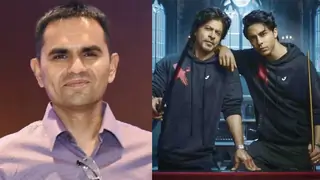Nothing in Indian popular culture has matched this magic. Critics might argue that Mother India' or Mughal-e-Azam' were better films, and trade pundits might point out that in 1994 Hum Aapke Hain Kaun' broke Sholay's box-office record. But none of these films can rival Sholay' in the scale and longevity of its success. Sholay' was a watershed event. Director Shekhar Kapur puts it best: There has never been a more defining film on the Indian screen. Indian Film history can be divided into Sholay' BC and Sholay AD.'
Sholay' grew from paper into plans, and it gained weight and size andambition.The Sippy's wanted to make Sholay' the biggest and the best adventure film ever, and they would make no compromises. The traditional 35mm format, they felt, wouldn't do justice to their vision. They were aiming for epic grandeur. So a decision was made: Sholay' would be India's first 70mm film with stereophonic sound. The 70mm film format offered double the size. The major Hollywood action movies at the time, such as Mckenna's Gold', were shot in this format because it gave the viewer, quite literally, a big movie experience. But the decision to do Sholay' in this format added another layer of compliations. Shooting in 70mm wasn't easy. It required huge camera's which could take 70mm film. Importing the camera's was an expensive proposition. The most practical solution was to shoot on 35mm and then blow it up for 70mm. The format was screen-tested. Divecha suggested putting aground glass in front of the camera lens, on which Kamlakar Rao, a young but technically skilled cameraman, made markings so the margins of the 70mm frame could be identified. Ramesh's brother Ajit, who lived in London, forwarded the test to Paris, where a 70mm print was made. The print came back with further instructions on how to perfect the technique. A 70mm film also required bigger screens, and most theatres in India weren't equipped for it. Then Sippy's decided to have two sets of negatives, one in 70mm and the other one in 35mm. In practical terms, this meant that every shot would have to be done twice. Each decision added to the cost.
AMJAD KHAN:
Amjad Khan filled the doorway. He was not a particularly large man, but his lumbering gait, thickset face and curly hair gave him the appearance of one. Director Ramesh Sippy was lying on the diwan with his back to the door. From the low angle, Amjad loomed larger. Something clicked. He had an interesting face,' says Ramesh. I felt very positive.' Panic had set in after Danny's departure. Shooting was less than a month away. And Gabbar Singh was no ordinary character. It was a pivotal role. The actor had to have both talent and charisma to hold his own against the galaxy of stars. Bad casting could destroy the film. Amjad was the younger son of character artiste Jayant. His home production, Patthar ke Sanam,which was supposed to launch him, was announced but never made. He had assisted K Asif in Love and God and also done a bit role in the film. The credentials were hardly impressive. But in theatre Amjad had a strong reputation. A few days after Danny left, Salim bumped into Amjad. Salim knew Amjad's father, and had been visiting their home since Amjad was a little boy. A polite conversation ensued in which Salim asked Amjad about work. There wasn't much, just bit roles and theatre.
Salim had heard about Amjad's skills as an actor, and physically he seemed to fit the role. I can't promise you anything,' he told Amjad, but there is a role in a big film. ll take you to the director. Agar aap ko yeh role mil jaaye, aap ki koshish se yea aapki kismat se (If you get this role, whether by luck or effort),I tell you, it is the finest role in this film.' Amjad seemed to fit the part, but he was unknown. Could he carry the film? He was asked to grow a beard and come back. Meanwhile, Ramesh and Salim-Javed pondered. Salim-Javed were convinced that Amjad was the right choice.
A screen test was done. They shot pictures in the office garden. Amjad had grown a beard and blackened his teeth. His diction was right, his language was perfect. He was confirmed for the role. Amjad hurried ecstatically to hospital to break the news to wife Shaila. The date was 20 September 1973. His son Shadaab was born that afternoon. Amjad prepared for Gabbar. Normal life took a back seat; this was clearly the best role fo his career. Amjad devoured Abhishapth Chambal, a book on the Chambal dacoits written by Jaya Bhaduri's father, Taroon Coomar. He marked out the pages on the real-life Gabbar, insisting that his wife Shaila read it too. He rehearsed his lines and fleshed out his character. He remembered a dhobi from his childhood days who used to call out to his wife: Arre o Shanti.' The lilt in Gabbar's Arre o Sambha' came from his dhobi.
Amjad was enthusiastic but insecure, and badgered his wife constantly: Do you think I'll be able to do it?' Of course,' she would say, you're a good actor. I've seen all your plays.' But this is a different ball game' So what? You've been part of Love and God'... your father is an actor...' All that dosn't matter. Do you think I'll be able to do this?'
The morning Amjad was to leave for Bangalore, he put the Quran on his head and prayed. Shaila was surprised. Amjad was a spiritual person but he rarely prayed. As abruptly as he had started, he stopped. He placed the holy book back in its place, said, I think I'll be able to do it,' and drove to the airport. The flight didn't reach Bangalore. There was a hydraulic failure, and the pilot was forced to keep circling over Mumbai. After dumping fuel for hours, the plane landed back in Mumbai. Amjad sat at the airport but didn't call home. After five hours, it was announced that the technical faults had been fixed and the plane was ready to take-off. Not many passengers had the stomach to get on that plane again Amjad was among the four or five who finally flew on it. He had to reach Bangalore. Through the flight, he wasn't thinking about his wife or his one month-old son. His only terror was: If this plane crashes, Danny gets Gabbar' (the first choice for the role but lost out to date commitments).
Gabbar Singh was not having a good day. It was Amjad's first day of shooting. They were starting with the scene in which he is introduced. His first line was, Kitne aadmi the?' All his life had led to this moment. The years of theatre rehearsals, knocking on doors for acting jobs, sweating it out as an assistant " the Gabbar role had made all that seem worthwhile. His army fatigues, picked up from Mumbai's Chor Bazaar, had the right weathered look. His teeth were blackened. His face was appropriately grimy. He had lived the part for the last few months. But now, when it was time to deliver, he just could not get it right. Gabbar had to mince tambaku (tobacco) as he talked. The motion of one hand grinding against another added to his menace. It was supposed to be his habit. But Amjad could not make it look casual. He would grind the tobacco, speak a few lines, look around awkwardly and then return to grinding. He was nervous and it showed; his hands were stiff, his movements seemed rehearsed, and his dialogue delivery was shaky. There was nothing natural about his performances; Gabbar was a stranger to Amjad.
Ramesh kept talking to him, trying to help him get his lines right. They struggled for two days. After forty-odd takes, both Ramesh and cameraman Dwarka Divecha decided the actor needed a break. Divecha told Amjad to keep his costume on and just sit on the sets. Tu apne aap ko season kar de (Season yourself).' Amjad cried that night. His father was in hospital fighting cancer. His son was only a month old. His family's hopes were pinned on this film. For the rest of the schedule, Amjad lived in the fatigues, trying to become Gabbar. He wrote often to his wife, but never shared with her the extent of his trauma. All he wrote was: I'm very impatient... I don't know... I hope I can do it.' Since he didn't drink, he would spend the evenings nursing endless cups of tea. Through the entire schedule, he didn't do a single shot.
In the next schedule, Amjad was more prepared. He got it right in the first few takes. He was living his character, and would stay in costume even when he was not shooting. But some members of the unit, unable to forget his earlier awkwardness, didn't seem to think this was enough. Besides, Amjad was the only new face in a sea of superstars and slowly talk started in the unit that perhaps Ramesh had made a mistake. The murmurs grew, till it became impossible even for Salim and Javed, who had been the most keen to have Amjad as Gabbar, to ignore them. Anxious, perhaps, to not be seen as people responsible for ruining the film, they spoke to Ramesh. If you aren't satisfied with Amjad, change him,' they said. For a few days the unit was rocked by rumours that Amjad was getting the boot. But Ramesh finally put his foot down. Only Amjad would play Gabbar.
Amjad found out about the rumours much later. But the incident sowed the seeds of misunderstanding between him and Salim-Javed. He could not understand why two people, who had ardently recommended him for the role, had then tried to get him thrown out. He saw it as a move to sabotage his career. The hurt stayed with him till his death. Salim-Javed gave birth to the Amjad myth, but they never worked with h



















6